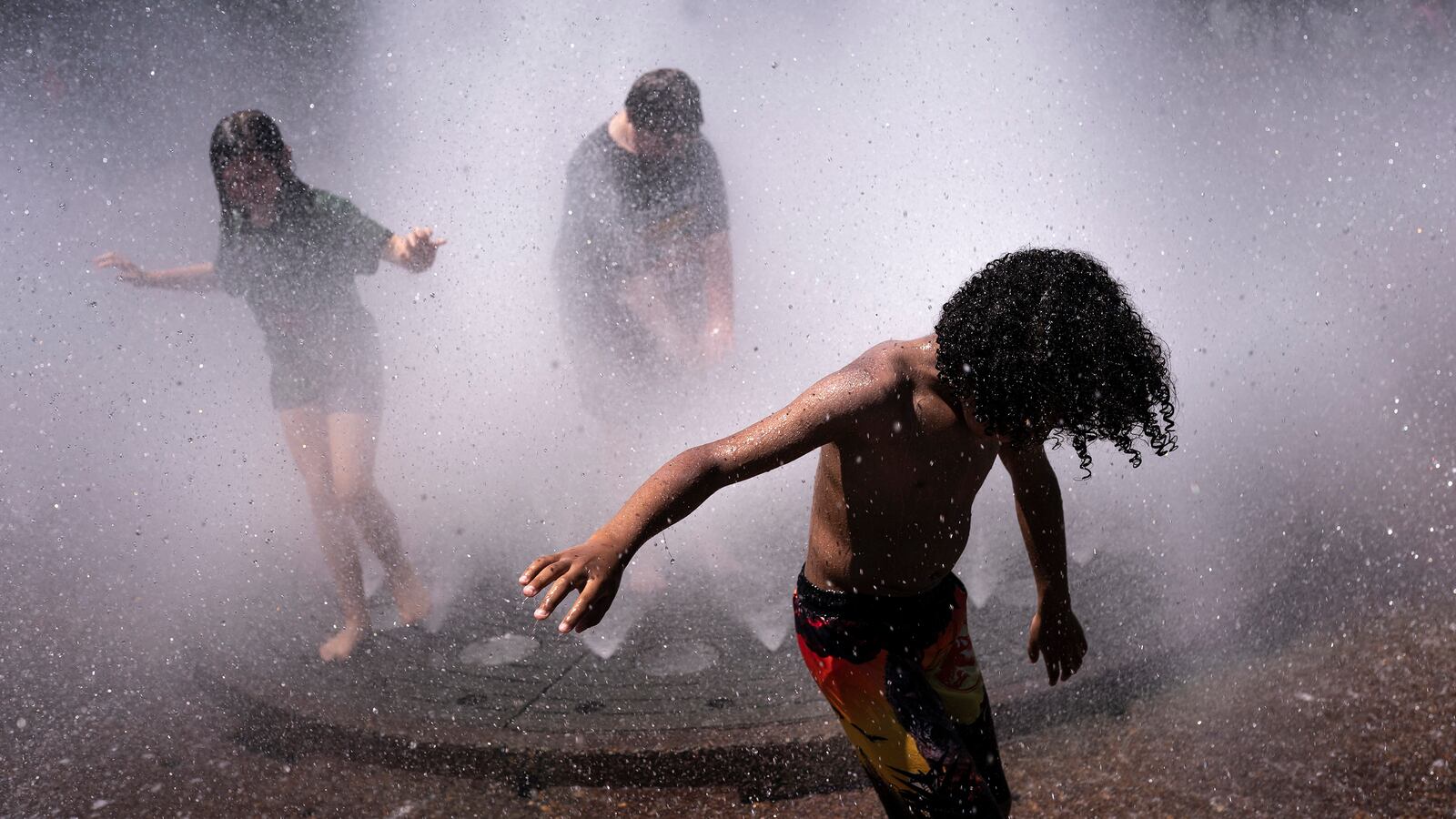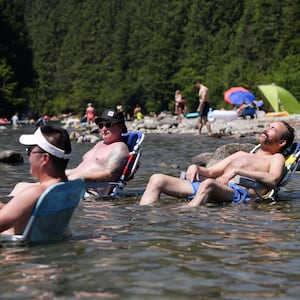Dale Durran just endured a historic heatwave in Seattle, and perhaps more than most residents, he’s got good reason to be confident climate change had something to do with the regional madness that proved especially extreme next door, in Oregon, where dozens died.
The professor of atmospheric sciences at the University of Washington told The Daily Beast that this past week’s monstrous stretch—which topped out at a blistering 108 degrees on Monday—was “so outside the range of previous hot spells in Seattle that it really stretches the credibility of anyone suggesting it is simply natural variability.”
Durran isn’t someone who blames climate change every time he breaks a sweat. But he does think about this issue: of accurately attributing seemingly insane weather events, like an entire village being on fire in Canada this past week, to a heating planet.
Last year, in his jargon-heavy paper “Can the Issuance of Hazardous-Weather Warnings Inform the Attribution of Extreme Events to Climate Change?” Durran closely examined something called the “probability of detection” and the “false alarm ratio.”
“The point of this article,” he explained, “is that demanding scientific certainty in the face of an event such as our recent record-crushing heatwave in the Pacific Northwest before accepting the need to take action to stem global warming is as ridiculous as demanding 100 percent certainty before issuing a tornado forecast.”
He’s not alone in thinking the doubters have run out of room—that events have overtaken any shred of sane skepticism.
According to legendary Princeton geoscientist Michael Oppenheimer, scientists are no longer guessing when it comes to tying extreme events like this to climate change, because a whole new field now exists that aims to tie a nice neat bow around these very questions.
“There is now a well developed science of ‘event attribution’ which deals with uncertainty,” Oppenheimer told The Daily Beast. (His own research over the years has focused on what the specific hazards of climate change will be, not necessarily event attribution.)
Here’s Oppenheimer’s explanation of how event attribution scientists do their jobs: They use Fractional Attribution of Risk (FAR), which he said is “the fraction of the intensity of an event (like a heatwave) that can be attributed to human-made greenhouse gases.” For example, event attribution scientists calculated the FAR on 2017’s Hurricane Harvey—after the fact—and it had, Oppenheimer explained, about two times what would have been the case without the greenhouse gases at 2017 levels. That gave Harvey a FAR score of 0.5.
Got all that?
It doesn’t really matter right now, because, according to event attribution specialist Emily Williams—currently still a Ph.D. student in geography at UC Santa Barbara—there’s no FAR score for what just happened to the West Coast. “Until a formal attribution study is done on this current heatwave,” Williams, who co-authored her university’s fact sheet on heatwaves and climate change, told The Daily Beast, “we won’t be able to say specifically how much more intense or likely climate change made it.”
However, Williams said, it’s nonetheless a “pretty safe bet to venture out and say that climate change likely at least exacerbated” the situation.
That’s because what scientists call the overall “probability distribution” of heatwaves has now shifted. So even though they haven’t looked backward at this latest event (or series of events) and tied it to climate change, enough science has been done to safely say the reverse—they more or less predicted this heatwave would happen. What those past scientists have already demonstrated, according to Williams, is that we’re now twice as likely to experience record breaking temperatures, that 16 percent of North America is now exposed to extreme heatwaves, and that when heatwaves arrive, “they’re now hotter.”
Matthew Hurteau, biology researcher at the University of New Mexico, studies the interaction between human behavior and the climate system, with an emphasis on fires—like the one that just consumed an entire Canadian town that had just set a national heat record of 121 degrees. Hurteau conducts his research by looking at reality, and a model of an unchanged climate.
“When I look at the climate change fingerprint on fire in my own research, it typically involves running simulations with and without the climate changing,” he told the Daily Beast.
But he doesn’t always need a model to be certain in his own mind that climate change is to blame when he sees a fire. “When the Creek Fire was burning in the Sierra Nevada last fall and I was looking at the energy release data from satellites and how long into the year it was actively burning,” he said, “it was clear that there was a climate change amplification of that fire.”
Still, it’s worth noting that some scientists find this comparison-to-an-unchanged-world methodology unsatisfying. Not because they believe recent extreme events should be regarded as normal, but simply because we live in the aforementioned changed world, and the other one is fake.
Matthew Igel, an atmospheric scientist focused on clouds at the University of California Davis, told The Daily Beast that now that we’ve filled our atmosphere with greenhouse gases, “We will always lack a realization of Earth without climate change regardless of how excellent our models are or become.”
According to Igel’s explanation, you can think of each attribution study almost as a science-fiction story about someplace called “Earth 2,” where anthropogenic climate change didn’t occur—perhaps because humans don’t exist there. And it’s only by creating a model of Earth 2 that we can understand why it’s so hot here on Earth 1, a.k.a. the only Earth that actually exists. “Our statistical knowledge of truly extreme events from some baseline climate will always be poor,” Igel said. “And regardless, just because we have never observed something before, doesn’t mean that it was impossible, only that it didn’t happen.”
By no means did Igel dismiss the usefulness of attribution science—he’s just hesitant to call it conclusive. “These are the questions that keep me up at night,” he explained.
But the attribution scientists can offer about the connection between climate change, and, for instance, your house being burned down in a wildfire, is good enough to be used in court. At least according to Michael Burger, Columbia Law professor, and executive director at the Sabin Center for Climate Change Law, which cooks up legal techniques to be used in the fight against climate change.
“There is nothing new about courts, or policymakers, making decisions in the face of probability calculations and varying degrees of scientific uncertainty. That’s the nature of the beast,” Burger explained. “As a lawyer, you have to deploy the science to make your case, and fit it to the relevant standard for the particular legal issue you are addressing.”
“Attribution Science has improved the precision of climate data with respect to delineation of atmospheric conditions with and without human caused greenhouse gases,” added Lindene Patton, a lawyer at the legal and advisory company Earth and Water Law Group.
When it comes to expert commentary before a judge, she said, “The state of the art attribution science is good enough—as good as morbidity data or demographic or other data we use.”
So the evidence—as in courtroom evidence—for climate change being the culprit in this heatwave, isn’t in quite yet. But that doesn’t mean the case against the defendant, anthropogenic climate change, isn’t looking extremely strong.
“Climate change caused by high levels of greenhouse gas changes all such events to some degree,” Oppenheimer said, “and I wait to see what the scientists who do these calculations say before deciding specifically how the character of an event was affected by the greenhouse gas buildup. That is precisely what I am waiting for now with regard to the recent heatwave in the Pacific Northwest.”
However, Oppenheimer added, “some events are so off the chart that you can say right off that there was very likely a big greenhouse gas contribution.” Hurricane Harvey, he said, was one of these instances where he didn’t need to wait for the evidence to be pretty sure. “There was no precedent even close to it in the local historical record. I think the same is true for the recent Pacific Northwest event.”
According to Williams, the UC Santa Barbara attribution specialist, events like this are “both a window into the future, and a reminder of why it’s so important that we take action now to transition to a just, low-carbon economy.”
Such a “just, low-carbon economy,” is still a long way off, and those who would stand on the sidelines poking holes in scientific conclusions have helped slow down its creation. According to Durran, we need to stop letting that happen, even if attribution science gets it wrong from time to time.
“Some errors will always occur both when issuing weather warnings and when distinguishing natural variability from human-induced climate change,” he said. “In neither case can we let the possibility of error completely paralyze our response.”


